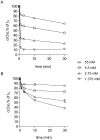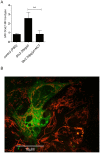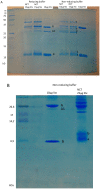N-chlorotaurine, a long-lived oxidant produced by human leukocytes, inactivates Shiga toxin of enterohemorrhagic Escherichia coli
- PMID: 23139739
- PMCID: PMC3491008
- DOI: 10.1371/journal.pone.0047105
N-chlorotaurine, a long-lived oxidant produced by human leukocytes, inactivates Shiga toxin of enterohemorrhagic Escherichia coli
Abstract
N-chlorotaurine (NCT), the main representative of long-lived oxidants produced by granulocytes and monocytes, is known to exert broad-spectrum microbicidal activity. Here we show that NCT directly inactivates Shiga toxin 2 (Stx2), used as a model toxin secreted by enterohemorrhagic Escherichia coli (EHEC). Bacterial growth and Stx2 production were both inhibited by 2 mM NCT. The cytotoxic effect of Stx2 on Vero cells was removed by ≥5.5 mM NCT. Confocal microscopy and FACS analyses showed that the binding of Stx2 to human kidney glomerular endothelial cells was inhibited, and no NCT-treated Stx2 entered the cytosol. Mass spectrometry displayed oxidation of thio groups and aromatic amino acids of Stx2 by NCT. Therefore, long-lived oxidants may act as powerful tools of innate immunity against soluble virulence factors of pathogens. Moreover, inactivation of virulence factors may contribute to therapeutic success of NCT and novel analogs, which are in development as topical antiinfectives.
Conflict of interest statement
Figures







Similar articles
-
Shiga toxin 2 reduces complement inhibitor CD59 expression on human renal tubular epithelial and glomerular endothelial cells.Infect Immun. 2013 Aug;81(8):2678-85. doi: 10.1128/IAI.01079-12. Epub 2013 May 20. Infect Immun. 2013. PMID: 23690395 Free PMC article.
-
Baicalein Inhibits Stx1 and 2 of EHE: Effects of Baicalein on the Cytotoxicity, Production, and Secretion of Shiga Toxins of Enterohaemorrhagic Escherichia coli.Toxins (Basel). 2019 Aug 29;11(9):505. doi: 10.3390/toxins11090505. Toxins (Basel). 2019. PMID: 31470657 Free PMC article.
-
Vitamin B12 Uptake by the Gut Commensal Bacteria Bacteroides thetaiotaomicron Limits the Production of Shiga Toxin by Enterohemorrhagic Escherichia coli.Toxins (Basel). 2016 Jan 5;8(1):14. doi: 10.3390/toxins8010014. Toxins (Basel). 2016. PMID: 26742075 Free PMC article.
-
Construction of a novel bioluminescent reporter system for investigating Shiga toxin expression of enterohemorrhagic Escherichia coli.Gene. 2011 Jun 1;478(1-2):1-10. doi: 10.1016/j.gene.2011.01.006. Epub 2011 Jan 22. Gene. 2011. PMID: 21262333 Review.
-
[Expression and extracellular release of Shiga toxin in enterohemorrahgic Escherichia coli].Nihon Saikingaku Zasshi. 2010 Dec;65(2-4):297-308. doi: 10.3412/jsb.65.297. Nihon Saikingaku Zasshi. 2010. PMID: 20505269 Review. Japanese. No abstract available.
Cited by
-
Current Opinion on the Therapeutic Capacity of Taurine-Containing Halogen Derivatives in Infectious and Inflammatory Diseases.Adv Exp Med Biol. 2022;1370:83-98. doi: 10.1007/978-3-030-93337-1_8. Adv Exp Med Biol. 2022. PMID: 35882784 Review.
-
Periplasmic methionine sulfoxide reductase (MsrP)-a secondary factor in stress survival and virulence of Salmonella Typhimurium.FEMS Microbiol Lett. 2023 Jan 17;370:fnad063. doi: 10.1093/femsle/fnad063. FEMS Microbiol Lett. 2023. PMID: 37403401 Free PMC article.
-
Activity of N-Chlorotaurine against Long-Term Biofilms of Bacteria and Yeasts.Antibiotics (Basel). 2021 Jul 22;10(8):891. doi: 10.3390/antibiotics10080891. Antibiotics (Basel). 2021. PMID: 34438941 Free PMC article.
-
Role of taurine, its haloamines and its lncRNA TUG1 in both inflammation and cancer progression. On the road to therapeutics? (Review).Int J Oncol. 2020 Sep;57(3):631-664. doi: 10.3892/ijo.2020.5100. Epub 2020 Jul 14. Int J Oncol. 2020. PMID: 32705269 Free PMC article. Review.
-
Tolerability of inhaled N-chlorotaurine in humans: a double-blind randomized phase I clinical study.Ther Adv Respir Dis. 2018 Jan-Dec;12:1753466618778955. doi: 10.1177/1753466618778955. Ther Adv Respir Dis. 2018. PMID: 29857780 Free PMC article. Clinical Trial.
References
-
- Grisham MB, Jefferson MM, Melton DF, Thomas EL (1984) Chlorination of endogenous amines by isolated neutrophils. J Biol Chem 259: 10404–10413. - PubMed
-
- Weiss SJ (1989) Tissue destruction by neutrophils. N Engl J Med 320: 365–376. - PubMed
-
- Koprowski M, Marcinkiewicz J (2002) Taurine chloramine - its role in immunity and new perspectives for clinical use. Centr Eur J Immunol 27: 69–74.
-
- Marcinkiewicz J (1997) Neutrophil chloramines: missing links between innate and acquired immunity. Immunol Today 18: 577–580. - PubMed
Publication types
MeSH terms
Substances
LinkOut - more resources
Full Text Sources
Molecular Biology Databases

